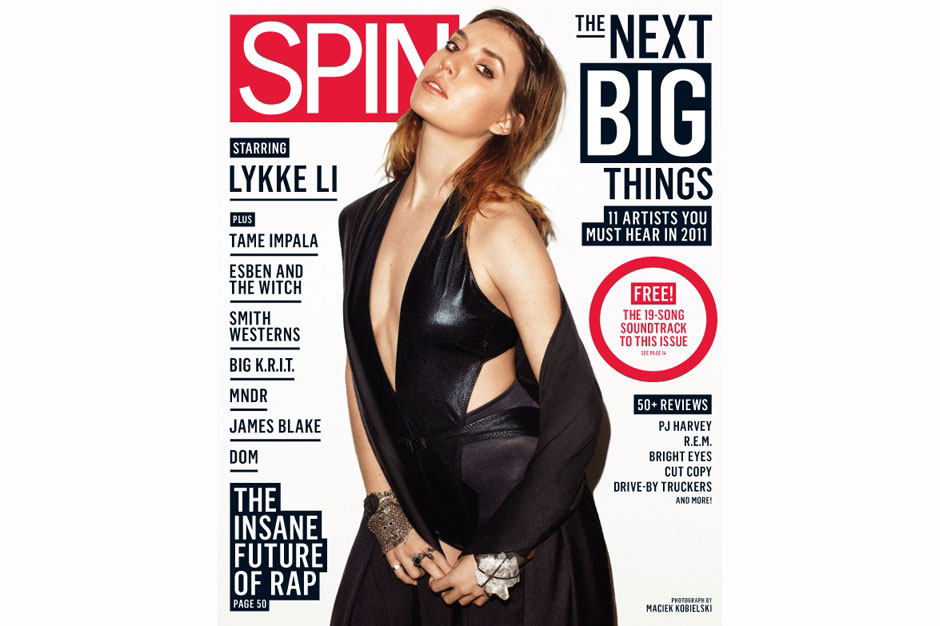Sweden’s latest contender for pop supremacy wants to be your prostitute, but also knows that selling herself isn’t going to make her happy. What’s a shy superstar-in-the-making to do? [Magazine Excerpt]
Sitting in a bustling Ukrainian diner in Manhattan’s East Village on the coldest morning of a young December, Lykke Li Zachrisson, swaddled in a bulky sweater, straightens her black leather newsboy cap, places her hands on both sides of her smooth, broad face, and tries to make things clear.
“My whole world is crazy right now,” the 24-year-old singer says quietly and thoughtfully, which is how she says most things. “I could just sit here and tell you” — she swaps her singsongy Swedish accent for a sarcastic celebuhonk — “I’m so grateful to be here. I love my life. But it’s better to be honest. Anyway, it’s all a big blur.” The fuzziness has a little to do with the whiskey she drank with friends late last night and a lot to do with her whirlwind week in New York City taking meetings, buying stage clothes, and attending parties in advance of the release of her second album, Wounded Rhymes (LL/Atlantic), out March 1. “I don’t even know if my Autoharp is in L.A. or Stockholm,” she says, dunking a bag of green tea into a large mug. “Yeah, it’s the rich-kid blues — I have a song about that — but that doesn’t mean the pressure doesn’t exist.” She is small, blonde, and possessed of piercing gray-green eyes. “I don’t want to be too negative, but I’m a Pisces. Pisces swim close to the mud.”
Pisces are restless, too, which is just as well because, as Holly Golightly says in Breakfast at Tiffany‘s, one of Lykke Li’s favorite books, people who get used to things might as well be dead. (Lykke, by the way, means happiness, which proves ironic, and is pronounced Likk-ya, making her name intriguing to me on at least two levels). Still, she tries to focus. To reach out. Because she suspects she’s an indigo child and she believes indigo children were born to hold hands with people all over the world.
“Maybe somebody will read this who needs to connect with me,” she says, and she can see my eyes start to roll, but she continues. “I’m fundamentally ambivalent about life in general, so of course I’m ambivalent about success. Is the world better because I’m here?” she says, and she has this Scandinavian way of saying bleak things and making them sound matter-of-fact rather than self-pitying or maudlin, as if her words were ash flicked from the end of an existential cigarette. “Ultimately, I hope you hear me and recognize yourself. That,” she says smiling, “would be the most incredible thing.”
Zachrisson knows full well that Wounded Rhymes‘ stylish dance-pop and crystalline ballads are an impressive step up from her debut, 2008’s Youth Novels. “Good things are happening,” she says, “but it’s scary to think that they’re happening because people expect things from me.”
And they expect a lot. “She’ll be a hugely significant act globally. That’s my belief,” says Atlantic Records U.K. chairman Max Lousada, who signed Zachrisson to the label in spring 2008 after Youth Novels‘ initial success in Sweden. “On her first record she was the submissive. Now she’s the dominant. I know massive success is going to happen. When? I’m not that clever. I just know it will.”
Novels, arguably more plaintive and searching than submissive, sold 62,000 copies in the United States and another 77,000 worldwide. Hardly staggering totals, but when combined with a magnetic stage presence that swings between naked fragility and feline ferocity — and that could prove capable of reaching both the poetry-reading wallflowers and madly texting social butterflies — the numbers are promising enough to make those with a vested interest feel they’ve got something.
“We’ll potentially have her in another Victoria’s Secret spot. I’m hot on ‘Jerome’ from the new record,” says music supervisor Vasili Gavre, who previously placed Novels‘ coquettish “Little Bit” in a TV ad for the lingerie company. “I can’t really go into details about what could happen, but it’s good for Lykke to be associated with Victoria’s Secret. They have deep pockets.”
That commerce flows both ways. “Lykke is a great ambassador for the brand,” says Morven Mackinnon, a spokesperson for Levi’s European division. “She’s cool. She’s hip, she’s credible.” Levi’s selected Lykke Li to be one of the faces for the company’s new Curve ID line.
Her peers are also excited. “Lykke Li’s incredible,” says Drake, who rapped over a remix of “Little Bit” on his 2009 So Far Gone mixtape (the same year she appeared alongside Kanye West on N.A.S.A.’s “Gifted”). “I love her. I hope you tell her that. I don’t understand why she’s not the biggest artist already. Everything in due time.”
Says who?
Lykke li likes to have her fortune read when she’s in New York, and this seems like a particularly ripe time to do it, so we pop into a tiny second-floor storefront decorated with crystal balls and Buddhas on St. Mark’s Place and pay $45 for Madame Anne-Marie to read her Tarot. She shuffles the deck and lays out 16 cards on a small circular table. A Siamese cat meows and rubs against my leg. Olive-skinned, wearing a blue fleece sweater and knockoff Uggs, with crusty red rashes beneath her brown eyes, Madame Anne-Marie sways as she stares at the cards. Then she begins:
“The coming year will represent a transition. You have the potential to achieve the success you desire, but that will not bring fulfillment. The wheel of fortune is around you — money will never be an obstacle. But I feel that you are meant to go through emotional pain, and that will take a toll on you. And in the next nine months to a year” — Zachrisson leans forward intently — “you should buy a house. Now what are your questions?”
“Can you see about the past?” Zachrisson asks. She nervously fingers a golden nameplate necklace that she bought not far from here six years ago, when she moved to Brooklyn for a few months and sang with the Bob Dylan wannabes at Greenwich Village open mics and walked around in furs and told people she was a Swedish pop star who just vanted to be alone and then would take the subway back to Bushwick at the end of the night.
“You lived your past,” scoffs Madame Anne-Marie. “Why go over it again? What we need to do is focus on the future. Here’s my card. I want you to come back so we can get your chakras aligned. Yes?”
Strolling north down First Avenue in the direction of an Italian café she likes, Zachrisson says that that fortune-teller was wrong. “A lot of how I think about music comes from when I was little,” she explains. As a child, along with her younger brother and older sister, she shuttled with her parents between Sweden, the house her father built on a hill in Portugal’s Algarve (where she improved her English watching Baywatch reruns), and villages in India and Nepal.
Her mother, Kärsti Stiege, had been a member of an all-girl punk band called Tant Strul before settling into photography. Her father, Johan, played guitar for Swedish reggae-rockers Dag Vag. (“When her demo came on my desk, I think two things,” says Ismail “Isse” Samie, the Swedish talent scout who helped Zachrisson get a Scandinavian record deal in 2007. “One, she’s good looking. Two, her parents played in cool bands. So I know she has the star quality.”)
This childhood didn’t feel as magical as it reads. “I used to sit in the car when we’d drive from place to place and hate not knowing what school I would be going to or who my friends would be,” remembers Zachrisson. “That traveling sounds like an adventure, but when you’re ten, you don’t care about climbing Annapurna, you care about a Coca-Cola. I would put on headphones and listen to Michael Jackson and Madonna tapes, and music would be my sacred place.”
Read the complete feature in the March 2010 issue of SPIN, on newsstands now. Additional reporting by William Goodman.





